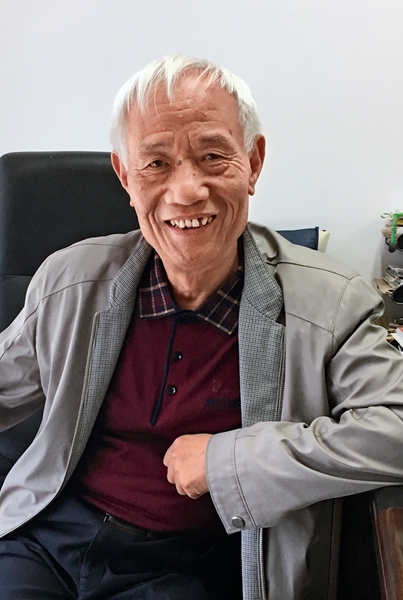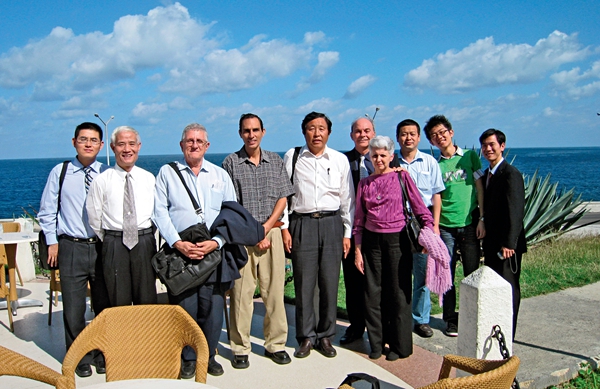By staff reporter ZHANG HONG
By staff reporter ZHANG HONG
DTMB (Digital Terrestrial Multimedia Broadcast) has set a mandatory national standard for Chinese digital television. Yang Zhixing was the first to take charge of developing this standard. At the end of 2011, thanks to the efforts of Yang and his team, the DTMB system was officially nominated an international standard, alongside those of the United States, the EU, and Japan. The International Telecommunication Union (ITU) declared DTMB to be “a milestone in the 40 years of global digital television development, between 1972 and 2012.”
Successful Digital Conversion
Murree is a small town located 1.5 hours’ drive from Islamabad, capital of Pakistan. Here, in the heart of the mountains at an altitude of 2,200 meters, is a cooperation project between Chinese and local companies with the aim of realizing the DTMB standard.

Yang Zhixing:
Professor at the Department of Electronic Engineering of Tsinghua University and director of National Engineering Laboratory for Digital TV (Beijing). He has led his team to develop DTMB, a mandatory national standard for Chinese digital television.
On April 20, 2015, Chinese President Xi Jinping and Pakistani Prime Minister Nawaz Sharif attended in Islamabad the inauguration ceremonies of several bilateral cooperation projects, including that for DTMB, the first in the China-Pakistan Economic Corridor.
Pakistan, one of the countries along the Belt and Road routes, is characterized by huge mountains, immense deserts and varied climate. A few years ago, Pakistan’s national television increased its research into digital television standards. At that time, the ITU had recognized only four standards worldwide: ATSC of the U.S., DVB-T/T2 of Europe, ISDB of Japan, and DTMB/DTMB-A of China. During the test phase, Pakistan was extremely impressed by the Chinese standard, whose potential exceeded all expectations, and therefore preferred DTMB above all the four available standards.
This standard was not developed overnight. Yang Zhixing witnessed its birth and growth. In the 1990s, foreign researchers began working to convert the analog signal to digital. In 1994, academics like Wu Youshou and Ye Peida, mentors of Yang Zhixing, urged the nation to seize the opportunity offered by the digital revolution in the television sector. This call caught the attention of China’s policy makers.

“China has long held the world record for the production of color TVs and domestic television ownership. However, in the days of first black-and-white, and then color television that preceded the transition to digital technology, China adopted the European standard without having intellectual property rights over key technologies,” explained Yang Zhixing. At that time, he was researching the development of satellite receiver demodulators, but he foresaw the potential of digital television. He understood that this technology would soon represent a major shift, allowing everyone to watch the small screen at high quality.
In 1999, the National Digital Television Leading Group was established in China with the aim of developing a domestic standard for digital television. In the same year, a research center specializing in digital tele-transmission techniques was established at Tsing-hua University. Yang Zhixing was in charge of this project.
“Digital has truly revolutionized the small screen. The quality is much better today than with analog TV,” Yang said.
Superiority of Chinese Standard
What are the strengths of the Chinese standard in comparison with the other three standards? In short, it is based on a stable system, has a high spectral efficiency, uses broadband and covers a wider area.
In addition, the Chinese standard adopts low-density parity check (LDPC), a new error-correction linear code. Invented by Robert Gallager, an American professor at the Massachusetts Institute of Technology (MIT) in the 1960s, the LDPC system ensured optimum error correction, but due to its technical complexity it was not until the 1990s that it was finally implemented. The group headed by Yang Zhixing was the first to integrate this LDPC system into a digital television standard. Nowadays, second-generation standards in Europe and the United States also use this LDPC system.
In August 2006, the Chinese standard was unveiled and became mandatory nationally. During the 2008 Beijing Olympic Games, this new standard was tested in the eight host cities of this competition, including Beijing, Shanghai and Zhuhai. It has since been extended to other Chinese cities and provinces, and with more investment could expand to nationwide coverage.
In 2006, Hong Kong announced its intention to adopt the European standard. Nevertheless, the following year, Yang Zhixing and his group visited Hong Kong, and their standard was trialed for six months. As the Chinese standard clearly surpassed that in force in Europe. Hong Kong then changed its mind and opted for the former. To date, 70 percent of Hong Kong viewers benefit.
Encouraged by this success in the Hong Kong market, between 2008 and 2009, Yang Zhixing repeatedly visited four Latin American countries, namely Cuba, Venezuela, Peru, and Ecuador. He made so many trips that he lost count. “Over two years, I have accumulated enough air miles on my Air China and Air France loyalty cards to qualify for a gold card, even though I flew economy class,” joked Yang Zhixing.
Yang Zhixing knows the foreign technologies inside out. He is certain of the excellence of the Chinese digital television standard. “It did not fail a single test!” he exclaimed, adding: “Of all the international standards, ours has been recognized as superior by all the countries that have tested it.”
In Venezuela, the local test involved five criteria, and the Chinese standard ranked first in four. Thanks to its constant high performance, it is gradually gaining a solid reputation internationally.
Diffusion of Advanced Technologies
Competition between terrestrial digital television standards, which have strong political connotations, is not comparable to that between two brands of ordinary products. Beyond the choice of the norm, it must be regarded as a symbol of national sovereignty.
A national working group was established in September 2009, consisting of members from eight ministries, including the National Development and Reform Commission and the Ministry of Foreign Affairs, with the aim of disseminating the Chinese digital TV standard globally. At the same time, the National Digital Television Leading Group decided to submit the Chinese standard to the ITU for its approval.
In 2011, the ITU paid close attention to the Chinese standard. It established a technical group specifically to monitor the development of the DTMB system. Representatives from 78 countries participated in this group. Finally, the Chinese standard was commended for its high performance and was recognized as an international standard.
Yang Zhixing is cognizant of the impact of the spread of a standard on the whole industrial chain. “In the new economic era, standards are a way of exploring new markets. In international competition, standards are a powerful means of overcoming adversaries,” he said.
Among the four systems of the first generation, the Chinese standard enjoys a significant advantage. This is why 14 countries and regions have now embraced the DTMB system in Asia, Africa and Latin America, covering nearly two billion people.
In addition to obtaining this precious status from the ITU, the superiority of this standard has earned Yang Zhixing and his group other honors, including the highest prize of the National Science and Technology Progress Award in 2016.
According to Pan Changyong, a researcher who has been working for years on the establishment of Chinese technological standards, “We must distinguish two types of products in ‘going global’: goods from the more traditional manufacturing industry, such as laptops, televisions, shoes, and clothing; and standards, which are part of the export of advanced technologies.”
In recent years, Europe has launched its second-generation international digital television standard, while Yang Zhixing and his group have upgraded the DTMB standard to DTMB-A. He now expects that in 2017, with the development of the Belt and Road Initiative, the industrial chain of the DTMB-A system will expand rapidly and that the Chinese standard will gain ground abroad.